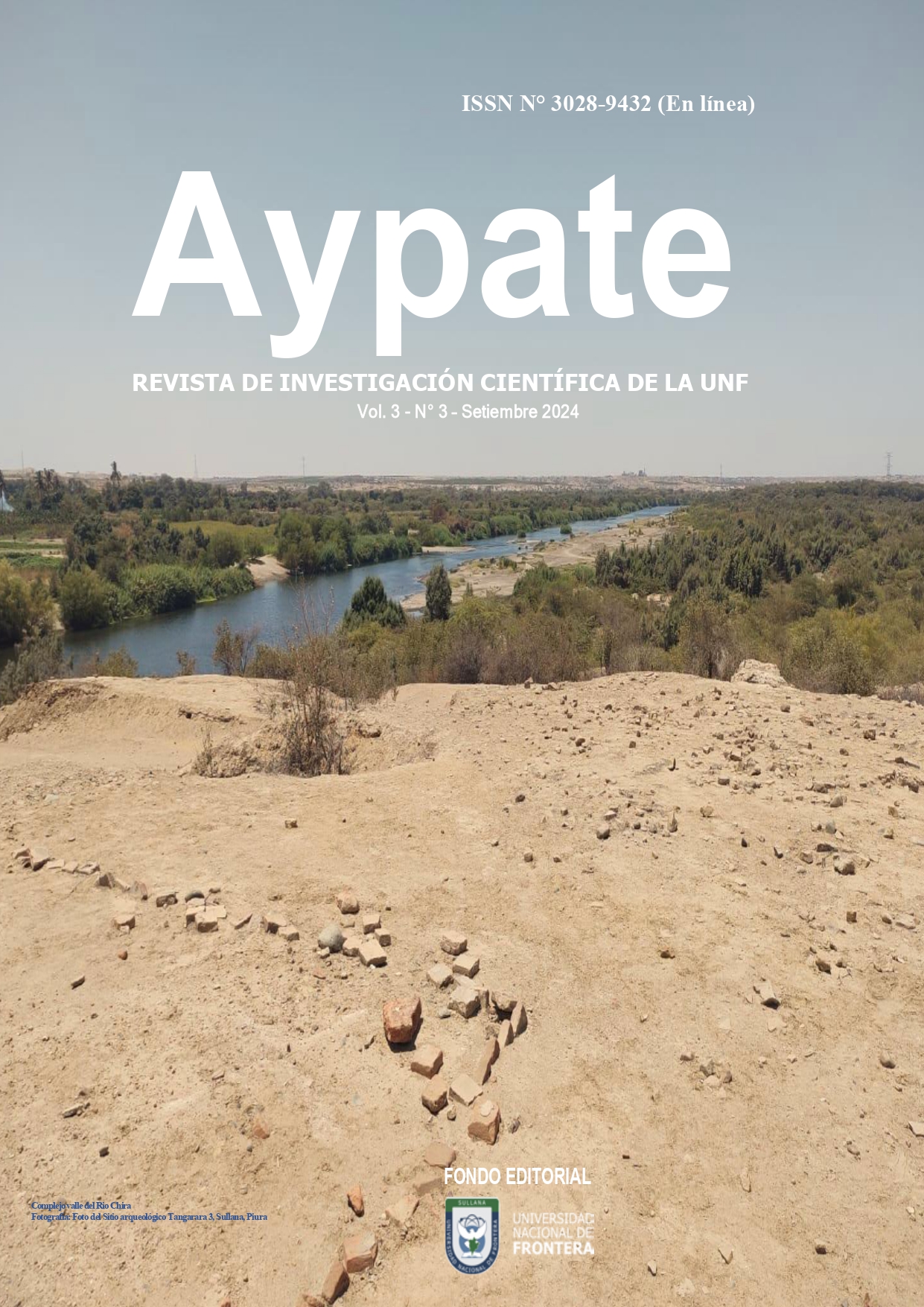Compuestos fenólicos totales en hojas de Neem (Azadirachta indica) del Norte Peruano: Efectos del secado y extracción asistida por ultrasonidos
DOI:
https://doi.org/10.57063/ricay.v3i3.118Keywords:
Compuestos bioactivos, compuestos fenólicos, EAU, Frecuencia, kHz, extracción convencionalAbstract
Las hojas de Azadirachta indica (Neem) son reconocidas por sus propiedades bioactivas. Este estudio evaluó el impacto de la temperatura de secado y la extracción asistida por ultrasonidos (EAU) en el contenido fenólico total de las hojas de Neem del norte del Perú. Métodos: Se recolectaron hojas de Neem del campus de la Universidad Nacional de Frontera. Estas se lavaron, secaron a temperaturas controladas (50, 60, 70 y 80 °C), molieron y almacenaron. La EAU se realizó utilizando etanol al 96% (2:40 p/v), frecuencias de 37 y 80 kHz durante 20, 30 y 40 minutos. También se realizó una extracción convencional por agitación para comparación. El contenido fenólico total se cuantificó usando el método de Folin-Ciocalteu. Se empleó un diseño factorial 4x2x3, analizando los datos mediante ANOVA y prueba de Tukey. Resultados: La temperatura de secado y las condiciones del ultrasonido influyeron significativamente en el contenido fenólico total. El mayor contenido (2177.3 ± 50.5 mg de GAE/100 g de hoja) se obtuvo con secado a 50 °C y ultrasonido a 37 kHz durante 30 minutos. El contenido más bajo se registró a 80 °C de secado y ultrasonido a 80 kHz por 20 minutos. Discusión: Los resultados sugieren que temperaturas de secado más bajas y tiempos de ultrasonido moderados son más efectivos para preservar los compuestos fenólicos en las hojas de Neem. La EAU es una alternativa prometedora para la obtención de extractos bioactivos que podrían emplearse para el desarrollo de ingredientes o envases funcionales. Se requieren más estudios para optimizar el proceso.
References
Abdel Moaty, A. A., El-Kholie, E. A., y Adarous, R. A. (2022). The Anti-Diabetic Effect of Neem Leaves (Azadirachta indica,) in Alloxan-Induced Diabetic Rats. Journal of Home Economics, 32(2), 19-31.
Abdulkadir, A. R., Mat, N., y Jahan, S. (2017). In-vitro Antioxidant Potential in Leaf , Stem and Bark of Azadirachta indica. Pertanika J. Trop. Agric. Sci, 40(4), 497-506.
Benelli, G., Canale, A., Toniolo, C., Higuchi, A., Pavela, R., y Nicoletti, M. (2016). Neem ( Azadirachta indica ): Towards the ideal insecticide ? Natural Product Research, 6419, 1-18. https://doi.org/10.1080/14786419.2016.1214834 DOI: https://doi.org/10.1080/14786419.2016.1214834
Braga, D. L., Mota, S. T. S., Zoia, M. A. P., Lima, P. M. A. P., Orsolin, P. C., Vecchi, L., Nepomuceno, J. C., Fürstenau, C. R., Maia, Y. C. P., Goulart, L. R., y Araujo, T. G. (2018). Ethanolic Extracts from Azadirachta indica Leaves Modulate Transcriptional Levels of Hormone Receptor Variant in Breast Cancer Cell Lines. Molecular Sciences, 19. https://doi.org/10.3390/ijms19071879 DOI: https://doi.org/10.3390/ijms19071879
Castillo Téllez, M., Pilatowsky Figueroa, I., Castillo Téllez, B., López Vidaña, E. C., y López Ortiz, A. (2018). Solar drying of Stevia (Rebaudiana Bertoni) leaves using direct and indirect technologies. Solar Energy, 159, 898-907. https://doi.org/10.1016/j.solener.2017.11.031 DOI: https://doi.org/10.1016/j.solener.2017.11.031
Charpe, T. W., y Rathod, V. K. (2012). Extraction of glycyrrhizic acid from licorice root using ultrasound: Process intensification studies. Chemical Engineering and Processing: Process Intensification, 54, 37-41. https://doi.org/10.1016/j.cep.2012.01.002 DOI: https://doi.org/10.1016/j.cep.2012.01.002
Datta, A., Grün, I. U., Kwasniewski, M. T., y Fernando, L. N. (2017). Comparison of Two Adsorbent Based de-Bittering Procedures for Neem ( Azadirachta indica A. Juss ) Tea- Effect on Polyphenols , Anti-Oxidant Capacity , Color and Volatile Profile. Plant Foods for Human Nutrition, 10-17. https://doi.org/10.1007/s11130-016-0595-9 DOI: https://doi.org/10.1007/s11130-016-0595-9
Dawood Shah, M., Venmathi Maran, B. A., Maran, V., Kit Tan, J., Soon Yong, Y., Fui Fui, C., Muhamad Shaleh, S. R., y Shapawi, R. (2021). The anti-leech potential of the solvent extract of Bornean neem leaves and ultra-high performance liquid chromatography-high-resolution mass spectrometry profiling. Journal of King Saud University - Science, 33(6), 101541. https://doi.org/10.1016/j.jksus.2021.101541 DOI: https://doi.org/10.1016/j.jksus.2021.101541
Devi, A., Jangir, J., y K.A., A. A. (2018). Chemical characterization complemented with chemometrics for the botanical origin identification of unifloral and multifloral honeys from India. Food Research International, 107, 216-226. https://doi.org/10.1016/j.foodres.2018.02.017 DOI: https://doi.org/10.1016/j.foodres.2018.02.017
Eze, M. O., Ejike, C. E. C. C., Ifeonu, P., Udeinya, I. J., Udenigwe, C. C., y Uzoegwu, P. N. (2022). Anti-COVID-19 potential of Azadirachta indica (Neem) leaf extract. En Scientific African (Vol. 16, p. e01184). Elsevier B.V. https://doi.org/10.1016/j.sciaf.2022.e01184 DOI: https://doi.org/10.1016/j.sciaf.2022.e01184
Fayoux, S., Hernandez, R., y Holland, R. (2007). The Debittering of Navel Orange Juice Using Polymeric Films. Food Engineering and Physical Properties, 72. https://doi.org/10.1111/j.1750-3841.2007.00283.x DOI: https://doi.org/10.1111/j.1750-3841.2007.00283.x
Fong-Lores, O., Berenguer-Rivas, C., de la Vega Acosta, J., Wawoe-Díaz, N., y Puente-Zapata, E. (2014). Antioxidant potential of an aqueous leaf extract of Neem (Azadirachta Indica A. Juss). Revista Cubana de Plantas Medicinales, 19(2), 205-207.
Godfrey, C. R. A. (1994). Agrochemicals from natural products. CRC Press. https://doi.org/10.1016/0167-8809(95)90095-0 DOI: https://doi.org/10.1016/0167-8809(95)90095-0
Gogate, P. R., Wilhelm, A. M., y Pandit, A. B. (2003). Some aspects of the design of sonochemical reactors. Ultrasonics Sonochemistry, 10(6), 325-330. https://doi.org/10.1016/S1350-4177(03)00103-2 DOI: https://doi.org/10.1016/S1350-4177(03)00103-2
Hamad, G. M., Mohdaly, A. A. A., El-Nogoumy, B. A., Ramadan, M. F., Hassan, S. A., y Zeitoun, A. M. (2021). Detoxification of Aflatoxin B1 and Ochratoxin A Using Salvia farinacea and Azadirachta indica Water Extract and Application in Meat Products. Applied Biochemistry and Biotechnology, 193(10), 3098-3120. https://doi.org/10.1007/s12010-021-03581-1 DOI: https://doi.org/10.1007/s12010-021-03581-1
Heidtmann Bemvenuti, R., Moser Tralamazza, S., Jorge Ferreria, C. F., Correa, B., y Badiale Furlong, E. (2016). Effect of natural compounds on Fusarium graminearum complex. Journal of the Science of Food and Agriculture, 96, 3998-4008. https://doi.org/10.1002/jsfa.7591 DOI: https://doi.org/10.1002/jsfa.7591
Hidar, N., Ouhammou, M., Mghazli, S., Idlimam, A., Hajjaj, A., Bouchdoug, M., Jaouad, A., y Mahrouz, M. (2020). The impact of solar convective drying on kinetics , bioactive compounds and microstructure of stevia leaves. Renewable Energy, 161, 1176-1183. https://doi.org/10.1016/j.renene.2020.07.124 DOI: https://doi.org/10.1016/j.renene.2020.07.124
Hismath, I., Wan Aida, W. M., y Ho, C. W. (2011). Optimization of extraction conditions for phenolic compounds from neem (Azadirachta indica) leaves. International Food Research Journal, 18(3), 931-939.
Hossain, M. D., Sarwar, M. S., Dewan, S. M. R., Hossain, M. S., Shahid-Ud-Daula, A., y Islam, M. S. (2014). Investigation of total phenolic content and antioxidant activities of Azadirachta indica roots. Avicenna journal of phytomedicine, 4(2), 97-102.
Ji-Won, L., Cho-Long, J., Ki Chang, J., Geun-Hyoung, C., Hee-Dong, L., y Jin Hyo, K. (2013). Investigation on the insecticidal limonoid content of commercial biopesticides and neem extract using solid phase extraction. 2(4), 81-85. DOI: https://doi.org/10.4236/jacen.2013.24012
Khairy, D., Osman, M. A., y Mostafa, F. A. M. (2022). Combined use of Aqueous Plant Extracts for Controlling Meloidogyne incognita and Modulating Chemical Constituents in Tomato under Greenhouse Conditions. Pakistan Journal of Nematology, 40, 1-11. https://doi.org/10.17582/JOURNAL.PJN/2022/40.1.1.11 DOI: https://doi.org/10.17582/journal.pjn/2022/40.1.1.11
Llanos Gonzáles, A., Sánchez Suárez, H., Ochoa Mogollón, G., Peralta Ortiz, T., y Ordinola-Zapata, A. (2020). Repellent effect of neem oil (Azadirachta indica A. Juss) against mosquitoes (Anophelex spp) in piglets. Revista de Investigaciones Veterinarias del Peru, 31(1), 1-11. https://doi.org/10.15381/rivep.v31i1.17544 DOI: https://doi.org/10.15381/rivep.v31i1.17544
Panda, D., y Manickam, S. (2019). Cavitation technology-the future of greener extraction method: A review on the extraction of natural products and process intensification mechanism and perspectives. Applied Sciences (Switzerland), 9(4). https://doi.org/10.3390/app9040766 DOI: https://doi.org/10.3390/app9040766
Patil, S. S., Deshannavar, U. B., Ramasamy, M., y Hegde, P. G. (2022). Modeling and optimisation studies on the ultrasound-assisted extraction of phenolic compounds from Azadirachta indica. Chemical Engineering Communications, 209(10), 1423-1438. https://doi.org/10.1080/00986445.2021.1976164 DOI: https://doi.org/10.1080/00986445.2021.1976164
Paul, R., Prasad, M., y K.Sah, N. (2011). Anticancer biology of Azadirachta indica (Neem): A mini review. 4047. https://doi.org/10.4161/cbt.12.6.16850 DOI: https://doi.org/10.4161/cbt.12.6.16850
Pijoan, M. (2004). Neem, The Village Pharmacy. Ethnopharmacy, 23.
Rao, P. R., y Rathod, V. K. (2015). Mapping study of an ultrasonic bath for the extraction of andrographolide from Andrographis paniculata using ultrasound. Industrial Crops y Products, 66, 312-318. https://doi.org/10.1016/j.indcrop.2014.11.046 DOI: https://doi.org/10.1016/j.indcrop.2014.11.046
Rinaldi, F., Hanieh, P. N., Maurizi, L., Longhi, C., Uccelletti, D., Schifano, E., Del Favero, E., Cantù, L., Ricci, C., Ammendolia, M. G., Paolino, D., Froiio, F., Marianecci, C., y Carafa, M. (2022). Neem Oil or Almond Oil Nanoemulsions for Vitamin E Delivery: From Structural Evaluation to in vivo Assessment of Antioxidant and Anti-Inflammatory Activity. International Journal of Nanomedicine, 17, 6447-6465. https://doi.org/10.2147/IJN.S376750 DOI: https://doi.org/10.2147/IJN.S376750
Rokhina, E. V, Lens, P., y Virkutyte, J. (2009). Low-frequency ultrasound in biotechnology: State of the art. En Trends in Biotechnology (Vol. 27, Número 5, pp. 298-306). https://doi.org/10.1016/j.tibtech.2009.02.001 DOI: https://doi.org/10.1016/j.tibtech.2009.02.001
Saha Tchinda, J. B., Mbitnkeu Fetngna Tchebe, T., Abdou, T., Cheumani Yona, A. M., Fauconnier, M. L., Ndikontar Kor, M., y Richel, A. (2021). Fatty acid profiles, antioxidant, and phenolic contents of oils extracted from Acacia polyacantha and Azadirachta indica (Neem) seeds using green solvents. Journal of Food Processing and Preservation, 45(2), 0-3. https://doi.org/10.1111/jfpp.15115 DOI: https://doi.org/10.1111/jfpp.15115
Santos, K. S., Barbosa, A. M., Freitas, V., Muniz, A. V. C. S., Mendonça, M. C., Calhelha, R. C., Ferreira, I. C. F. R., Franceschi, E., Padilha, F. F., Oliveira, M. B. P. P., y Dariva, C. (2018). Antiproliferative activity of neem leaf extracts obtained by a sequential pressurized liquid extraction. Pharmaceuticals, 11(3), 76. https://doi.org/10.3390/ph11030076 DOI: https://doi.org/10.3390/ph11030076
Sejali, S. N. F., y Anuar, M. S. (2011). Effect of drying methods on phenolic contents of Neem (Azadirachta indica) leaf powder. Journal of Herbs, Spices and Medicinal Plants, 17(2), 119-131. https://doi.org/10.1080/10496475.2011.584293 DOI: https://doi.org/10.1080/10496475.2011.584293
Shewale, S. P., Kapadia, M., y Rathod, V. K. (2022). Process Intensification Intensification of total phenolic compounds extraction from Azadirachta indica (Neem) leaves by ultrasound. Chemical Engineering and Processing - Process Intensification, 181(January), 109099. https://doi.org/10.1016/j.cep.2022.109099 DOI: https://doi.org/10.1016/j.cep.2022.109099
Shewale, S., y Rathod, V. K. (2018). Extraction of total phenolic content from Azadirachta Indica or ( Neem ) leaves: Kinetics study Extraction of total phenolic content from Azadirachta Indica or ( Neem ) leaves: Kinetics study. Preparative Biochemistry and Biotechnology, 6068. https://doi.org/10.1080/10826068.2018.1431784 DOI: https://doi.org/10.1080/10826068.2018.1431784
Shirsath, S. R., Sonawane, S. H., y Gogate, P. R. (2012). Intensification of extraction of natural products using ultrasonic irradiations—A review of current status. Chemical Engineering y Processing: Process Intensification, 53, 10-23. https://doi.org/10.1016/j.cep.2012.01.003 DOI: https://doi.org/10.1016/j.cep.2012.01.003
Soma, M., y Satarupa, M. (2021). Neem: Treasure of Natural Phytochemicals. Chem Sci Rev Lett, 10(39), 369-401. https://doi.org/10.37273/chesci.cs205205351
Taralkar, S. V., Chattopadhyay, S., y Gaikar, V. G. (2016). Parametric optimization and modeling of batch extraction process for extraction of betulinic acid from leaves of Vitex Negundo Linn. Separation Science and Technology (Philadelphia), 51(4), 641-652. https://doi.org/10.1080/01496395.2015.1105822 DOI: https://doi.org/10.1080/01496395.2015.1105822
Tiwari, B. K. (2015). Ultrasound: A clean , green extraction technology. Trends in Analytical Chemistry, 71, 100-109. https://doi.org/10.1016/j.trac.2015.04.013 DOI: https://doi.org/10.1016/j.trac.2015.04.013
Vats, S. (2015). Effect of Initial Temperature Treatment on Phytochemicals and Antioxidant Activity of Azadirachta indica A. Juss. Applied Biochemistry and Biotechnology, 178(3), 504-512. https://doi.org/10.1007/s12010-015-1890-x DOI: https://doi.org/10.1007/s12010-015-1890-x
Vetal, M. D., Lade, V. G., y Rathod, V. K. (2013). Extraction of ursolic acid from Ocimum sanctum by ultrasound: Process intensification and kinetic studies. Chemical Engineering and Processing: Process Intensification, 69, 24-30. https://doi.org/10.1016/j.cep.2013.01.011 DOI: https://doi.org/10.1016/j.cep.2013.01.011
Yang, Y., y Zhang, F. (2008). Ultrasound-assisted extraction of rutin and quercetin from Euonymus alatus ( Thunb .) Sieb. 15, 308-313. https://doi.org/10.1016/j.ultsonch.2007.05.001 DOI: https://doi.org/10.1016/j.ultsonch.2007.05.001
Yu, X., Gouyo, T., Grimi, N., Bals, O., y Vorobiev, E. (2016). Ultrasound enhanced aqueous extraction from rapeseed green biomass for polyphenol and protein valorization partir de biomasse verte Valorisation des polyph eines a de colza par extraction aqueuse assist ee par ultrasons. 19, 766-777. https://doi.org/10.1016/j.crci.2016.03.007 DOI: https://doi.org/10.1016/j.crci.2016.03.007







